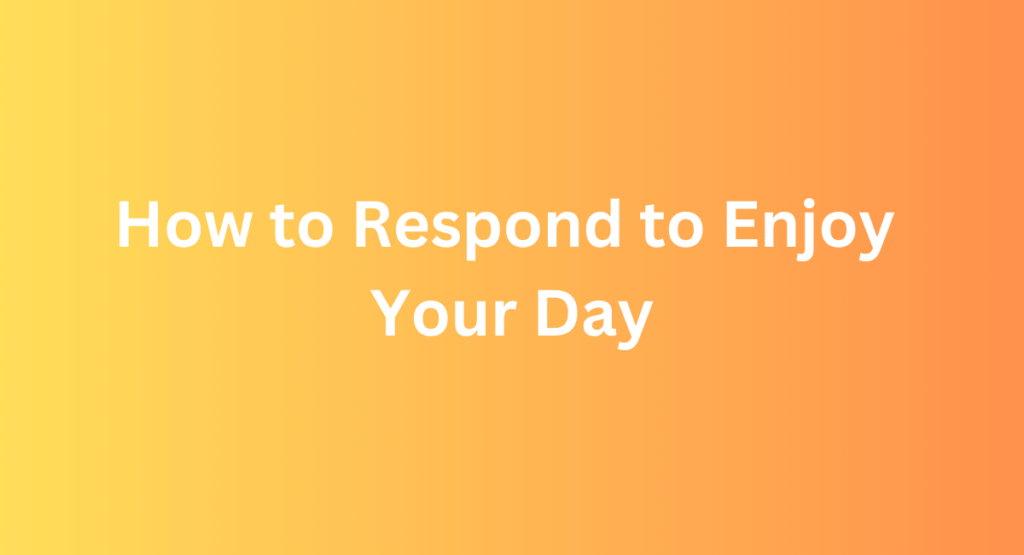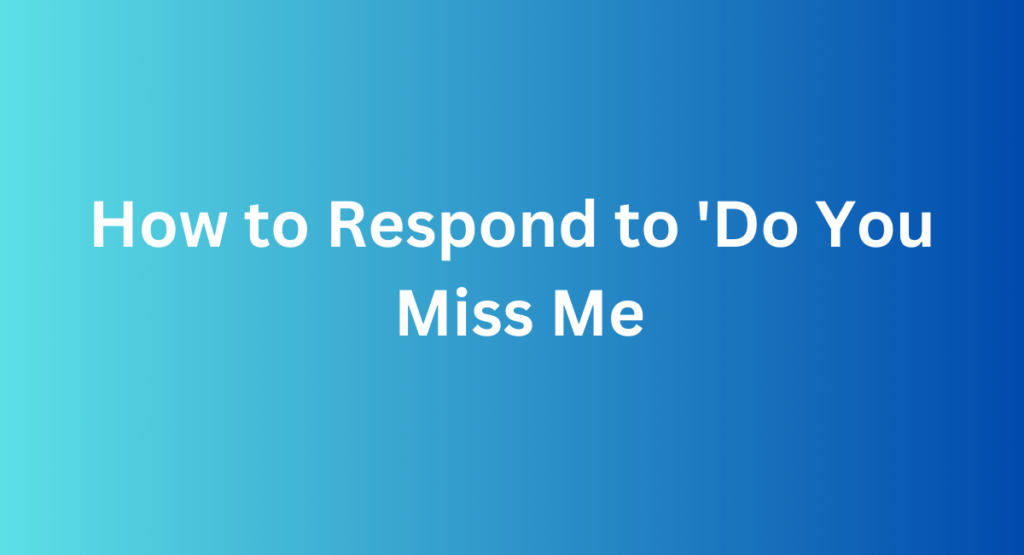
“I’ve been thinking about you too. How have you been?”
**** Expressing that someone has been thinking about you can evoke a range of emotions. It might make you feel special, nostalgic, or even curious. Responding appropriately can help strengthen your connection. A thoughtful reply can open the door to a meaningful conversation.
It shows you value the other person’s thoughts and feelings. Whether it’s a friend, family member, or someone special, your response matters. It’s an opportunity to rekindle relationships or deepen existing ones. Keep the conversation flowing by asking questions and sharing your thoughts. This approach fosters mutual understanding and builds stronger bonds.
Immediate Responses
Hearing the words “I’ve been thinking about you” can bring a mix of emotions. Your response can set the tone for your relationship with the sender. Immediate responses are essential as they show your attentiveness and care. This guide will help you craft the perfect reply.
Acknowledge The Message
When someone says, “I’ve been thinking about you,” it’s crucial to acknowledge their message promptly. This shows you value their thoughts and effort. Here are some ways to do so:
- Respond quickly: A timely response shows that you appreciate their message.
- Be genuine: Express sincere interest in their thoughts.
Here are some examples:
| Situation | Response |
|---|---|
| Close Friend | “Hey, it’s great to hear from you! I’ve been thinking about you too.” |
| Acquaintance | “Hi! Thanks for reaching out. How have you been?” |
Remember to keep your tone warm and inviting. A simple acknowledgement can foster deeper connections and show that you value the person’s thoughts.
Express Appreciation
After acknowledging the message, it’s essential to express appreciation. This lets the sender know you value their thoughts and time. Here are some tips to express your gratitude:
- Be specific: Mention something particular you appreciate about their message.
- Show gratitude: A simple “Thank you” can go a long way.
Here are some examples:
| Situation | Response |
|---|---|
| Close Friend | “Thank you for thinking of me! It means a lot.” |
| Acquaintance | “I appreciate your message. It brightened my day!” |
Expressing appreciation strengthens relationships and makes the sender feel valued. It’s a small gesture that can have a big impact.
Further Engagement
Receiving a message that says, “I’ve been thinking about you,” can be heartwarming. It opens the door to further engagement. This is your chance to deepen the connection. Responding thoughtfully can make a big difference. Here are some tips to keep the conversation flowing smoothly and meaningfully.
Initiate A Conversation
Starting a conversation can be simple yet effective. A good response shows you care. You might say, “That’s sweet! I’ve been thinking about you too.” This not only acknowledges their message but also reciprocates the sentiment.
Use open-ended questions to keep the conversation going:
- What have you been up to lately?
- Any exciting news to share?
Share something about yourself. This encourages them to do the same:
- I’ve been working on a new project. How about you?
- Just got back from a trip. Have you traveled anywhere recently?
Compliments can add warmth to your response:
- You always know how to make my day better.
- Your messages always bring a smile to my face.
Here’s a simple table to summarize these points:
| Action | Example |
|---|---|
| Acknowledge their message | I’ve been thinking about you too! |
| Ask open-ended questions | What have you been up to? |
| Share about yourself | I’ve been working on a project. |
| Give a compliment | You always brighten my day. |
Ask About Their Thoughts
Delving into their thoughts shows genuine interest. You can ask, “What made you think of me?” This question is direct yet friendly. It encourages them to open up.
Follow up with more questions based on their response:
- That’s interesting. Tell me more.
- I love hearing your thoughts on this.
Show empathy and understanding. If they share something personal, respond with care:
- That sounds challenging. I’m here for you.
- Thanks for sharing that with me.
Use their responses to build the conversation. For example:
- If they mention a hobby, say, “I’ve always wanted to try that.”
- If they talk about work, ask, “How’s that project going?”
Bullet points for quick reference:
- Ask what made them think of you.
- Follow up on their answers.
- Show empathy and understanding.
- Build on their responses.
Expressing Your Feelings
Hearing someone say “I’ve been thinking about you” can stir a mix of emotions. Expressing your feelings in response to such a heartfelt message is essential. It shows that you value the connection and are willing to open up. Let’s explore some ways to express your feelings effectively.
Sharing Your Emotions
When someone says they’ve been thinking about you, it’s important to share your emotions. This shows that you appreciate their thoughts and feelings. Here are some ways to do that:
- Be Honest: Share how you feel about hearing from them. Say something like, “It makes me happy to know you’re thinking of me.”
- Show Gratitude: Express your thanks. You might say, “Thank you for reaching out. It means a lot to me.”
- Share Your Thoughts: Let them know if you’ve been thinking about them too. For example, “I’ve been thinking about you as well. It’s great to hear from you.”
Here is a table summarizing how to share your emotions:
| Action | Example |
|---|---|
| Be Honest | “It makes me happy to know you’re thinking of me.” |
| Show Gratitude | “Thank you for reaching out. It means a lot to me.” |
| Share Your Thoughts | “I’ve been thinking about you as well. It’s great to hear from you.” |
Offering Support
Offering support is a great way to respond. It shows that you care and are there for them. Here are some tips:
- Ask How They Are: Show genuine concern. Ask, “How have you been?” or “Is everything okay?”
- Offer Help: Let them know you’re available. Say something like, “If you need anything, I’m here for you.”
- Stay in Touch: Suggest keeping in touch more often. You could say, “Let’s catch up soon. I miss our talks.”
Here’s a table summarizing ways to offer support:
| Action | Example |
|---|---|
| Ask How They Are | “How have you been?” or “Is everything okay?” |
| Offer Help | “If you need anything, I’m here for you.” |
| Stay in Touch | “Let’s catch up soon. I miss our talks.” |
Setting Up A Meeting
Receiving a message that says, “I’ve been thinking about you” can be both exciting and nerve-wracking. It’s important to respond thoughtfully and set up a meeting. This way, you can have a meaningful conversation. Setting up a meeting involves scheduling a time to talk and choosing the right setting.
Scheduling A Time To Talk
When scheduling a time to talk, ensure both parties are available. Consider these tips:
- Check Availability: Ask for their availability and share yours. This helps find a common time slot.
- Be Flexible: Offer multiple time options. This shows you’re considerate of their schedule.
- Use a Calendar Tool: Tools like Google Calendar or Doodle make scheduling easier. You can avoid back-and-forth messages.
For example, your message could look like this:
Hi [Name],
I'd love to catch up. I'm free on Tuesday at 3 PM or Thursday at 5 PM. Do either of these times work for you?
Best,
[Your Name]
Here’s a simple table to organize potential meeting times:
| Day | Time |
|---|---|
| Monday | 10 AM – 12 PM |
| Tuesday | 3 PM – 5 PM |
| Thursday | 5 PM – 7 PM |
Using these strategies ensures a convenient meeting time for both parties.
Choosing The Right Setting
Choosing the right setting is crucial for a productive conversation. Consider these points:
- Choose a Quiet Place: Select a location free from distractions. This allows for clear communication.
- Comfort Matters: Pick a comfortable spot. This makes both of you feel at ease.
- Public or Private: Decide if the meeting should be in public or private. Coffee shops are great for casual talks, while private spaces work for sensitive topics.
Here are some setting options:
- Coffee Shop: Ideal for casual and friendly conversations.
- Office or Meeting Room: Suitable for professional or serious discussions.
- Park: Perfect for a relaxed and open atmosphere.
Ensure the setting aligns with the conversation’s tone. This enhances the overall experience.
Handling Different Scenarios
Receiving a message like “I’ve been thinking about you” can stir various emotions. It’s essential to handle such situations thoughtfully, whether you share the same feelings or not. Here, we explore how to respond to this message in different scenarios.
If You Feel The Same Way
If you feel the same way, it’s an exciting moment. You want to express your feelings genuinely and clearly. Here are some ideas:
- Be Honest: Tell them you’ve been thinking about them too. For example, “I’ve been thinking about you a lot lately too.”
- Share a Memory: Mention a special moment you shared. For instance, “Remember that time we went to the beach? I can’t stop thinking about it.”
- Ask a Question: Show interest in their feelings. Ask, “What made you think of me?”
| Scenario | Response |
|---|---|
| You recently spent time together | “I’ve been thinking about our last weekend together. It was so fun!” |
| Shared a meaningful moment | “I’ve been thinking about that amazing dinner we had. It was unforgettable!” |
| You have feelings for them | “I’ve been thinking about you too. I really like you.” |
Keep it Light: If you’re unsure about their exact feelings, keep your response light and friendly. For example, “That’s so sweet! I was just thinking about you too!”
If You Don’t Feel The Same Way
If you don’t feel the same way, it’s important to be kind and clear. You don’t want to hurt their feelings, but you also need to be honest. Here are some tips:
- Be Honest: Let them know gently that you don’t share the same feelings. For example, “I appreciate you sharing your feelings, but I see us as friends.”
- Be Kind: Use kind words to soften the message. For instance, “You’re a wonderful person, but I don’t feel the same way.”
- Set Boundaries: Make your stance clear to avoid confusion. Say, “I value our friendship, and I hope we can continue being friends.”
| Scenario | Response |
|---|---|
| Friend expresses feelings | “I’m touched that you think of me, but I see us as friends.” |
| Colleague shares thoughts | “Thank you for sharing. I value our professional relationship.” |
| Someone you just met | “It’s nice to hear that, but I don’t feel the same way.” |
Keep it Respectful: Always use respectful language. For example, “I appreciate your honesty, but I see us as just friends.”
Maintaining Communication
Hearing someone say, “I’ve been thinking about you,” can be heartwarming. It’s essential to maintain communication to keep the connection strong. Responding thoughtfully ensures the conversation stays engaging and meaningful.
Keeping The Conversation Going
After someone shares that they’ve been thinking about you, keeping the conversation going is vital. Here are some tips to achieve that:
- Ask Open-Ended Questions: Encourage them to share more. Questions like “What have you been thinking about?” or “Is there something specific on your mind?” keep the dialogue flowing.
- Share Related Experiences: Relate to their thoughts by sharing similar experiences or feelings. This creates a bond and shows empathy.
For example, you could respond:
“I’ve been thinking about our last trip together. Do you remember how much fun we had at the beach?”
Another effective strategy is using prompts to delve deeper into the conversation. Here’s a simple table for some conversation prompts:
| Prompt | Example Question |
|---|---|
| Memories | “What made you think about that memory?” |
| Feelings | “How did that make you feel?” |
| Future Plans | “Do you have any plans related to this?” |
Active listening also plays a crucial role. Nod, smile, and give verbal affirmations like “I understand” or “That’s interesting” to show you’re engaged.
Showing Genuine Interest
Showing genuine interest is key to making the person feel valued. Here are some ways to show you care:
- Ask Follow-Up Questions: This shows you’re paying attention. For instance, “You mentioned you’ve been thinking about our last conversation. What stood out to you?”
- Express Your Feelings: Share how their thoughts make you feel. Say, “It means a lot to me that you’ve been thinking about us.”
Body language can also convey interest. Maintain eye contact, smile, and use gestures that show openness. This makes the conversation more personal.
Another approach is to share something special in return. For example:
“I’ve also been thinking about you. Remember that song we both love? It played on the radio today.”
Being empathetic is crucial. If they share something troubling, respond with empathy and support. Say, “I’m here for you. Let’s talk more about it.”
Finally, recap and revisit previous conversations. Mentioning past talks shows you remember and care. “Last time, you mentioned you were stressed about work. How are things now?”
Frequently Asked Questions
What Does “i’ve Been Thinking About You” Mean?
“I’ve been thinking about you” means someone has had you on their mind. It shows they care about you.
How Should I Respond To “i’ve Been Thinking About You”?
Respond with appreciation and interest. For example, “That’s sweet, I’ve been thinking about you too. “
Why Do People Say “i’ve Been Thinking About You”?
People say this to express affection or interest. It shows they value their relationship with you.
Is “i’ve Been Thinking About You” Romantic?
It can be romantic, but it depends on the context. It often indicates emotional or affectionate feelings.
Conclusion
Responding to “I’ve been thinking about you” can be simple and heartfelt. Remember to be genuine and considerate. Your response can strengthen connections and build deeper relationships. Always listen and respond thoughtfully. This approach ensures meaningful and lasting interactions, fostering trust and mutual respect.


